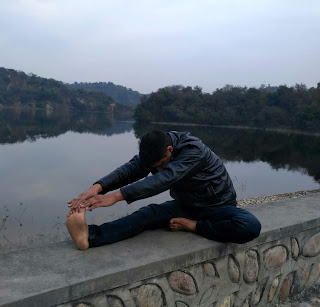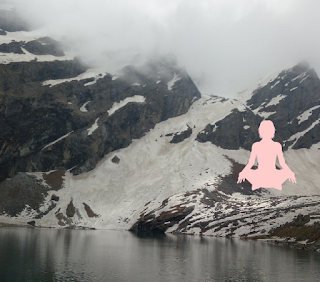Seven Asanas, Mudras and Pranayama that keep you healthy, energized and mentally fit
The Lungs, heart, liver, spleen,
small intestine and kidneys are majors’ organs of the body that need to always
be in good condition if one wishes to be in good health forever. All of these
organs are linked to our emotions and mental state. In fact, manifestation of
the health entirely depends on the performance of the organs.
Yoga and other forms of exercise help to
release excess heat from the organs through the fascia which surrounds each of
our body’s organs which regulate its temperature. If any organ is overheated,
it affects the balance of the five elements and prana energy flow, each organ has
their element e.g. the lungs control the metal element, kidneys control the
water element, the liver is the largest gland in the body and controls the wood
element and the eyes are its external organs. The Liver has more than 600
separate functions, produces bile which controls the breakdown and digestion;
further excretion of fats from the body and coverts protein and fats in to
carbohydrates and the storing of it, regulates blood sugar level, and acts to
detoxify toxins from the body; and of course it is the store house of vitamins,
minerals, metals and others substances. Today we focus on kidneys and its
function and how to revitalize it through asanas and pranayama. The other organs will be discussed in the subsequent
article.
Kidneys control the cold element
in the body; insufficient heat and excessive cold in the kidneys results in the
water element being imbalanced within and kidneys cannot work efficiently to
regulate the water element to cool off the body. Each element of the five
elements have distinct positive or negative aspects. The negative aspect comes from
the imbalance of the water element in the kidneys which links to fear. Excessive
cold which comes from the kidneys only weakens the middle and lower back
muscles especially the psoas muscles which surrounds the spine and runs down
either side of the groin which is near of the kidneys that supports the body to
erect. Being stiff without sufficient heat cuts off the prana energy flow in
the lower chakras that only manifest physical problems such as back pain, leg
problems and being unable to uplift the body.
The emotional affects are fear, insecurities
and fatigue. The well-known saying ‘frozen
with fear’ and ‘the icy fingers’
manifest only the cold water element that symbolises fear. Excessive cold in
the kidneys keeps one in fear but can be neutralised by proper breathing
technique, exercises and positive thinking that allows the positive emotion to
manifest. The positive aspect of it is wisdom and enthusiasm. Beneficial asanas,
mudras and pranayama for the kidneys are:
https://yogantastic.blogspot.com/2019/02/how-to-do-padam-asana-benifits.html
Find a quiet place and sit down
on the ground with legs straight in front.
Fold the legs by placing the left
foot on the right thigh and the right foot on left thigh.
Place both the heels as near to
the abdomen as possible while knees touch the ground.
Rest hands on the knees with the
palms facing upwards with the index finger touching the middle portion of the
thumb, spine lengthening up.
Shoulders should be remain loose
and arms fairly straight.
Breathe naturally.
Sit in this asana for as long as
possible.
Benefits:
Padam asana strengthens legs,
waist, shoulders and spine resulting in good posture. Enhances the respiration
rhythmically and balances the mind. It can help ladies with menstrual
discomfort and sciatica. As well as restoring energy levels.
https://yogantastic.blogspot.com/2018/08/kapala-bhati-how-keeps-body-fit-and.html
Steps to follow: process 1.
1. Sit comfortably and keep your back
straight.
Close your right nostril with your
thumb of right hand.
Inhale through the left nostril until
you have filled your lungs, this should take about 1 to 2 seconds.
Close the left nostril with your two
fingers middle and ring of your right hand while opening the right nostril.
Exhale slowly through the right
nostril slowly until all air has been released, this should take about 2 to 3
seconds.
The breathing should be quick and
gradual without holding the breath.
Do the same with your right nostril as
inhaling through the right nostril and taking out through the left nostril.
Repeat by alternating between the
nostrils.
2. Now inhale through the left nostril
and inhalation and exhalation should be performed rapidly by the right nostril
for 10 times. Do the same with the left nostril.
Two minutes are enough in the
beginning and build up to 10 minutes.
It can be done when both the nostrils
are open and can be done by using both nostrils, sitting in the siddhasana or
comfortable posture by using Mulabandha and partial uddiyan bandha. Perform
exhalation rapidly; in kapậla bhậti exhalation should be done forcibly and
quickly.
Process 2.
Exhalation is the prime factor of the
exercise; and while inhalation is only the auxiliary part of kapậla bhậti.
Inhalation and exhalation are rapidly done through both nostrils
simultaneously. Exhalation should be done forcibly and quickly by contracting
the abdominal muscles with backward push. A vigorous practice of it just for a
few minutes would vibrate every tissue of the body; and the diaphragm recedes
into the thoracic cavity by expelling all the air from lungs, the abdominal
viscera will be recalibrate easily.
Generally three round are carry out at
each sitting and twice a day enough and as ten or more may be added each week;
that finally 120 expulsions can be done at each round.
Benefits
It helps to awaken certain nerve
centres and further makes the practices of the pranayama more efficiently by
quieting the respiratory centre. A few minutes are enough to induce a trance
state when the aspirant has fully mastered the practice. It purify all the
Nadis of the body.
https://yogantastic.blogspot.com/2018/04/sarvang-asana-is-second-asanaamong-four.html
Steps to follow:
·
Begin with lie on ground with arms near the body
and keeps legs close.
·
Stretch legs outward the sole of the feet.
·
Stretch and lift the legs up towards head gently
and waist also from ground.
·
Support the waist with hands as elbow remain on
the ground.
·
Straighten legs up.
·
Bring
heals and shoulders to vertically position and just like a making 90◦ angle.
·
Avoid any load of the body on the head, load
must be upon the shoulders. Press your chin firmly into the base of your throat
and breathe slowly.
·
Stay in this asana for one-two minutes. And
watch your toes.
·
While coming down be sure that the legs should
been towards the head a little to maintain the balance of the body and avoid
any jerk.
·
Rest the arms straight on the floor for support,
while lower the legs slowly without raising the head from the floor/ground
·
Do shava-asana (read former article).
After shava-asana should be done
matsya-asana and paschimottan-asana for better results.
Benefits: Sarvang asana increases
flow of blood sufficiently towards spine, neck and head. It enhances strength
and flexibility of neck, moreover it strengthens the heart and brain, as well as
improving cardio respiratory endurance, muscular strength and muscular
endurance.it cures all stomach problems like: swollen feet, dysentery and
stomach-aches. Troubles of small-intestine; shifting throbbing of intestines from
navel is corrected.
4 Sarvottan Asana
- Lie down on the floor, put both the hands-on stomach with fingers crossed as turn palms outwards and exhale.
- Stretch arms then take them slowly behind the head while breathing in.
- Stretch toes forward whilst breathe normally.
- Keep the body stretched for some minutes as your body permit you after that bring back the arms slowly and put on the stomach.
- Relax toes and breathe normally but deep.
https://yogantastic.blogspot.com/2019/02/garud-asana-how-to-do-how-it-named.html
Stand erect and breathe normally.
Shift weight on to the left leg.
Entwine the right leg over the
left leg and same way the right arm entwined over the left arm in front of the
chest up to the face.
The toes of the right foot on the
inside of the left ankle.
Keep the body straight and keep
balance of the body, look straight in front of you.
Bend your left legs and lower
your trunk.
Hold the pose and breathing
deeply (for one minute or more as per your will).
Slowly raise your body up and
relax for a while.
Repeat for the other side.
Repeat three times on both sides.
For beginners, you can take
support of a wall to help you balance.
Benefits:
Garud asana cures legs, spine and
arms problems and makes them flexible and strong. Garud asana develops more Concentration and courage as all
the muscles and veins of the body get more rejuvenated energy and strength.
6 Nadi
shudhi pranayama:
Close the right nostril with
thumb of the right hand and breathe in slowly and filling the stomach with air
as it comes from of your left nostril and be ensure stomach will be expand
outside as filling the air in it.
Close the right nostril with
right thumb and breathe in and out from left nostril for 10 breathes ensure the
stomach expands during inhalation and contracts during exhalation.
Now close the left nostril with
ring finger and small finger as well and hold the breath comfortably.
Exhale slowly from the right
nostril by keeping your left nostril closed with small and ring finger. Now
breathe in and out from the right nostril for 10 breathes. Then close the right
nostril and hold the breath comfortably and then exhale slowly from the left
nostril.
Repeat all the above steps three
times and ensure that the last breath you take is exhaling from your left
nostril.
Relax for some time.
Benefits:
Quite safe as compare to other
types of the pranayama as it cures all types of problems such like as
constipation, falling hairs, eyes problem, concentration, laziness, back pain,
stomach problems and nervous system. This pranayama remove all diseases as it
purifies the Nadis, improve digestion and blood-circulation and provides
enthusiasm.
https://yogantastic.blogspot.com/2019/01/maha-mudra-how-to-do-spiritual-benefits.html
Sit in a posture pressing the
perineum with the heel of the left foot.
Stretch the right leg forward.
Inhale and retain the breath.
Hold the right toe with both
hand.
Holding the breath and bend forward
contracting the neck in (the chin is pressed naturally against the chest or
jalandhar bandha).
Continue holding the breath and Meditate
in between the two eye brow (Third eye and chanting small mantra e.g. Om).
While in the bent forward position.
Exhale and Release the mudra
slowly as visualize sending the warm prana energy down to the base of the
spinal column.
Repeat the entire procedure with
the right leg.
Benefits:
A sensation or heat may be felt
in the spine and the chakras after practicing Maha-mudra as the body stores the
energy. This is in fact, the flow of prana energy within body. The mind
liberated from the unhealthy thoughts while achieving complete stillness which
will further enhance the working in coordination with cosmic energy of other
planes and also rectifying the working of the unconscious mind and
super-conscious mind.
Maha mudra cures consumption,
piles, and enlargement of spleen, gulma, indigestion, fever, constipation and
leprosy; and prolonged life.




Filled with a alot of informative content
ReplyDeleteKeep it up sir
Very nice collection of Asanas, Mudras and Pranayama with each one providing great benefits for better health
ReplyDeleteVery nice sir👍👌
ReplyDelete👍👍👍👍👍👌👌
ReplyDeleteI recently found many useful information in your website especially this blog page. Among the lots of comments on your articles. Thanks for sharing.
ReplyDeleteYoga for liver